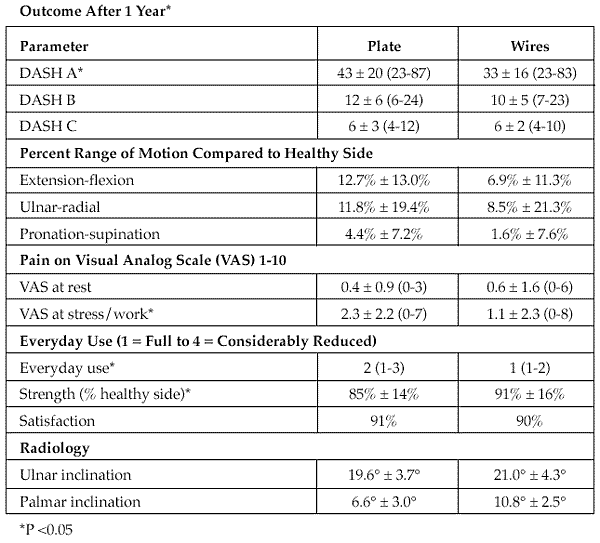
Fri., 10/9/09 Upper Extremity, Paper #52, 12:08 pm OTA-2009
Prospective Randomised Treatment of Distal Radius Fractures in the Elderly: Are Fixed Angle Implants Superior to K-Wire Osteosynthesis?
(FDA=Non-U.S. research conducted within guidelines of my country)
Christian Probst, MD1 (7-MedArtis Co., Basel, Switzerland); Rebekka Schmidt, MD1 (n);
Katja Briese, MD1 (n); Ralph Gaulke, MD1 (n);
Christian Krettek, MD1 (7-MedArtis Co., Basel, Switzerland);
Reinhard Meier, MD2 (7-MedArtis Co., Basel, Switzerland);
1Hannover Medical School, Department of Trauma, Hannover, Germany;
2Würzburg University Hospital, Department of Trauma, Würzburg, Germany
Purpose: Fractures of the distal radius are among the most common fractured regions in humans, even more so in the elderly. Additionally, operative fixation of fractured osteoporotic bone represents a big challenge for orthopaedic surgeons. Currently, there is a lively discussion on the proper treatment strategies. The actual study tries to contribute valuable evidence to this discussion.
Methods: We included 64 consecutive patients ≥60 years of age. Inclusion criterion was acute (<72 hours) Colles-type distal radius fracture. Exclusion criteria were pre-existing disease/injury of the fractured wrist, malignancy, diabetes, rheumatoid diseases, and/or immunosuppression. Randomization was performed in our emergency department after informed consent was obtained for randomized surgery by either Kirschner wire (K-wire) osteosynthesis or fixed-angle palmar plate (Aptus System, Medartis). Standardized follow-up after 1 year included clinical examination by an orthopaedic surgeon, DASH (Disabilities of the Arm, Shoulder and Hand) score, range of movement, grip strength (Jamar dynamometer), and standardized 2-plane radiographs. Distribution was into “plate” and “wires“. Comparison was done using Student t test and chi-squared test where applicable. Significance was set at P <0.05.
Results: 64 patients (plate, n = 31; wires, n = 33) finished 1-year follow-up. We included predominantly women (plate, 77%; wires, 90%) and right-handed patients (plate, 94%; wires, 100%), and more commonly the nondominant side was fractured (plate, 71%; wires, 63%). The 1-year outcome is shown in the table below. Complications were found in 3 patients (plate, 1; wires, 2).

Conclusion: Patients treated by K-wires and cast or external fixator show improved outcome compared to the plate group. Not differentiating between detailed fracture types and patient demands, 1 year after fracture treatment at the distal radius, morbidity due to the surgical approach or implants may impair patient outcome.
• The FDA has not cleared this drug and/or medical device for the use described in this presentation (i.e., the drug or medical device is being discussed for an “off label” use). ◆FDA information not available at time of printing. Δ OTA Grant